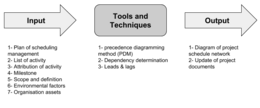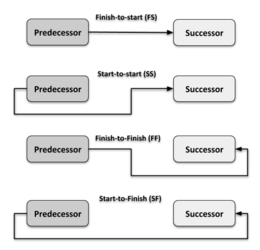Four types of dependency
Developed by Behzad Sanie
Contents |
Abstract
Dependency in project management means that one activity is depended to another.[1] The purpose of dependency determination is indicating the type of dependency that makes a logical relationships between predecessor and successor activities. Four types of dependency defined as: Finish-to-start (FS), Finish-to-finish (FF), Start-to-start (SS), Start-to-finish (SF).[2] The precedence diagramming method (PDM), as an example of the application of dependency, includes the four types of independencies or logical relationships.
Introduction
In project time managing, defining the sequence of the activities is necessary for documenting and recognising the relationship between each activities. The point is defining a logical sequence between tasks to do and increase efficiency during the project limitations. The sequence activity process includes inputs, tools and techniques, and output. The input will be plan of scheduling management, list of activity, attribution of activity, milestone, scope and definition, environmental factors and organisation assets. The application tools and techniques are precedence diagramming method (PDM), dependency determination and leads & lags. The expected outputs are diagram of project schedule network and update of project documents.[3]
The precedence diagramming method (PDM)
PDM is a tool for programming activities in planning a project. It is a method of constructing a network diagram of the project schedule that uses boxes, called nodes, to represent the activities and connects them with arrows that show the dependencies. PDM, In a network technology project, focuses on the precedence of activities and logical relationships. It is also known as the activity-on-node or AON and used by many project management software packages.
Types of dependencies
Four types of dependencies or logical relationship are linking predecessor activity and successor activity together in PDM. Predecessor activity comes before successor activity which is logically a depended activity in a schedule planning. Example: collecting data in a software project management is a predecessor activity and analysing the data is a successor activity. An activity must be time bound with a start and end time. This time bounding acquires the four types of dependencies between predecessor and successor which defined below:
- Finish-to-start (FS): A successor activity can start when a predecessor activity has finished. Example: building the walls (successor) in a house cannot start before finish the foundation (predecessor).
- Finish-to-finish (FF): A successor activity can finish when a predecessor activity has finished. Example: Wall construction (predecessor) is required to finish before electrical wiring (successor) inside the walls can finish.
- Start-to-start (SS): A successor activity cannot start if a predecessor activity has not begun. Example:
- Start-to-finish (SF): A successor activity cannot finish if a predecessor activity has not begun. Example:
Dependency determination
Dependencies identify by the following attributes:
- Mandatory dependencies
- Discretionary dependencies
- Internal dependencies
- External dependencies
Reference
- ↑ GRANDE-BRETAGNE. (2017). Managing successful projects with PRINCE2.
- ↑ Project Management Institute. (2013). A guide to the project management body of knowledge (PMBOK® Guide). 5th ed. Pennsylvania: Project Management Institute, pp. 156-159.
- ↑ Project Management Institute. (2013). A guide to the project management body of knowledge (PMBOK® Guide). 5th ed. Pennsylvania: Project Management Institute, pp. 153.

